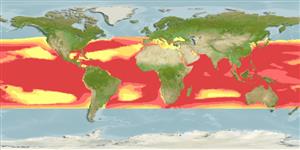Common names from other countries
分類 / Names
俗名 | 同種異名 | Catalog of Fishes(屬, 種) | ITIS | CoL | WoRMS | Cloffa
Elasmobranchii
板鰓亞綱 (鯊魚與魟魚) (sharks and rays) >
Lamniformes (Mackerel sharks)
鼠鯊目 (Mackerel sharks) >
Alopiidae (Thresher sharks)
狐鮫科 (Thresher sharks)
Etymology: Alopias: From alopex, Greek for fox, referring to the ancient vernacular “fox shark,” from its supposed cunning (ancients believed that when it took a bait, it swallowed the hook until it got to the cord, which it bit off and so escaped). (See ETYFish); superciliosus: super (L.), over and above; ciliosus (L.), haughty or having a raised eyebrow, referring to enormous upward- looking eyes set high on head and/or marked groove over eyes. (See ETYFish).
More on author: Lowe.
Environment: milieu / climate zone / depth range / distribution range
生態學
海洋; 海洋洄游的 (Ref. 51243); 深度上下限 0 - 730 m (Ref. 89423), usually 0 - 100 m (Ref. 43278). 亞熱帶的; 46°N - 40°S, 180°W - 180°E (Ref. 54278)
Circumglobal; tropical and temperate seas. Highly migratory species.
Circumtropical。 西大西洋: 美國的紐約州向南至巴哈馬與古巴; 巴拿馬 (參考文獻 6871) 到烏拉圭.(參考文獻 58839) 東大西洋: 葡萄牙到安哥拉, 包括地中海。 印度-太平洋: 阿拉伯海,馬達加斯加,南非,日本南部,台灣,越南北部 (參考文獻 13570) ,新加勒多尼亞,澳洲西北海岸,紐西蘭與東太平洋的夏威夷群島北部與南部: 南加州 (美國) ,哥斯大黎加與巴拿馬 (參考文獻 9253), 加拉巴哥群島高度遷移的種, 1982年海事法會議的附件一.(參考文獻 26139)
Length at first maturity / 大小 / 重量 / 年齡
Maturity: Lm 253.0, range 154 - 341 cm
Max length : 488 cm TL 雄魚/尚未辨別雌雄; (Ref. 40637); common length : 350 cm TL 雄魚/尚未辨別雌雄; (Ref. 5217); 最大體重: 363.8 kg (Ref. 40637); 最大年齡: 20 年 (Ref. 28081)
背棘 (總數) : 0; 臀棘: 0. A large thresher with very large eyes, an indented forehead, a broad caudal tip, and curved broad-tipped pectoral fins; 1st dorsal fin further back than in other threshers (Ref. 5578). Upper lobe of caudal fin very long and strap-like almost or quite equal to length of rest of shark; lower lobe short but well developed (Ref. 13570). Purplish grey above, cream below, posterior edges of pectoral and pelvic fins and sometimes first dorsal fin dusky; light color of abdomen not expanded over pectoral-fin bases (Ref. 13570).
一種大的長尾鮫有非常大的眼,一個凹入的前額,一個寬的尾部頂端與彎曲的頂端寬的胸鰭; 第一背鰭更向後面超過在其他的長尾鮫中.(參考文獻 5578) 尾鰭上葉非常長而帶狀的幾乎或相當等於其他鯊魚的長度; 下葉短但是發展良好的.(參考文獻 13570) 背面紫灰色的﹐腹面乳黃色的, 胸鰭與腹鰭的後緣與有時第一背鰭暗色的; 淡色的腹部不擴散到胸鰭基底了。 (參考文獻 13570)
Occurs in coastal waters over continental shelves, sometimes close inshore in shallow waters, and on the high seas far from land (Ref. 247, 43278, 58302). Oceanic, pelagic and near bottom at 1->500 m (Ref. 58302). Depth range to at least 500 m (Ref. 247). Feeds on pelagic fishes (lancetfishes, herring, mackerel and small billfishes (Ref. 43278)) and bottom fishes (hake (Ref. 43278)) and squids (Ref. 247). Ovoviviparous, embryos feeding on yolk sac and other ova produced by the mother (Ref. 43278, 50449). Stuns its prey with its long caudal fin (Ref. 247). Utilized for human consumption, liver oil for vitamins, skin for leather, and fins for shark-fin soup (Ref. 247). Marketed fresh and may be broiled, baked or grilled, but unsuitable for steaming, boiling or frying; meat may be salted and dried (Ref. 9987). Also Ref. 33743.
出現於在大陸棚上的沿岸水域, 有時近岸淺水區水域, 而且在公海上遠離土地.(參考文獻 247,58302) 大洋性的﹐大洋性的與近的底部在單一 >500 公尺的.(參考文獻 58302) 深度範圍到至少 500 公尺.(參考文獻 247) 吃大洋性與底棲性的魚與烏賊。 (參考文獻 247) 卵胎生的, 胚胎吃產生於母親的卵黃囊與其他的卵.(參考文獻 50449) 打昏它的獵物用它的長尾鰭.(參考文獻 247) 供人類食用, 肝油用於維他命,皮膚用做皮革與鰭用於魚翅湯.(參考文獻 247) 在市場上銷售生鮮地而且可能是火烤的﹐燒烤的或烤的, 但是不適於蒸煮或油炸; 肉可能是鹽醃而乾燥的.(參考文獻 9987) 也參考文獻 33743.
Exhibit ovoviparity (aplacental viviparity), with embryos feeding on other ova produced by the mother (oophagy) after the yolk sac is absorbed (Ref. 50449). With 2-4 young per litter (usually 2) (Ref. 247). Size at birth between 64-106 cm (Ref. 247); 100-140 cm TL (Ref.58048). No fixed mating or birthing season. Distinct pairing with embrace (Ref. 205). Circumtropical。 西大西洋: 美國的紐約州向南至巴哈馬與古巴; 巴拿馬 (參考文獻 6871) 到烏拉圭.(參考文獻 58839) 東大西洋: 葡萄牙到安哥拉, 包括地中海。 印度-太平洋: 阿拉伯海,馬達加斯加,南非,日本南部,台灣,越南北部 (參考文獻 13570) ,新加勒多尼亞,澳洲西北海岸,紐西蘭與東太平洋的夏威夷群島北部與南部: 南加州 (美國) ,哥斯大黎加與巴拿馬 (參考文獻 9253), 加拉巴哥群島高度遷移的種, 1982年海事法會議的附件一.(參考文獻 26139)
Compagno, L.J.V., 1984. FAO Species Catalogue. Vol. 4. Sharks of the world. An annotated and illustrated catalogue of shark species known to date. Part 1 - Hexanchiformes to Lamniformes. FAO Fish. Synop. 125(4/1):1-249. Rome, FAO. (Ref. 247)
人類使用
漁業: 商業性; 游釣魚種: 是的
工具
特別的報告
下載 XML
網路資源
Estimates based on models
Preferred temperature (Ref.
115969): 19.2 - 29, mean 27.1 (based on 6320 cells).
Phylogenetic diversity index (Ref.
82804): PD
50 = 0.7500 [Uniqueness, from 0.5 = low to 2.0 = high].
Bayesian length-weight: a=0.01096 (0.00596 - 0.02017), b=2.91 (2.75 - 3.07), in cm Total Length, based on LWR estimates for this species & (Sub)family-body (Ref.
93245).
營養階層 (Ref.
69278): 4.5 ±0.0 se; based on diet studies.
回復力 (Ref.
120179): 低的, 最小族群倍增時間4.5 - 14 年 (tm=7; tmax=20; K=0.088; Fec=2-4).
Prior r = 0.23, 95% CL = 0.15 - 0.34, Based on 1 data-limited stock assessment.
Fishing Vulnerability (Ref.
59153): Very high vulnerability (85 of 100).
Climate Vulnerability (Ref.
125649): High vulnerability (63 of 100).
